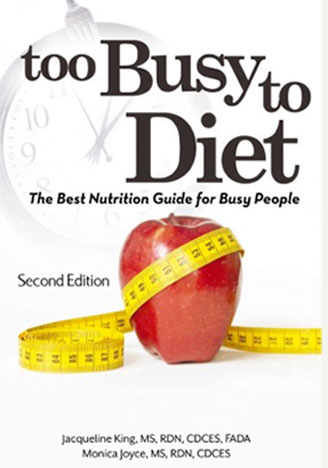DASH to a Healthy Heart
in The Too Busy to Diet Blog on February 23, 2016
DASH To A Healthy Heart
February is Heart Health Awareness Month. According to the Centers for Disease Control, high blood pressure, high cholesterol, and smoking are three key risk factors for heart disease.
About 47% of Americans have at least one of these three risk factors. Several other medical conditions can also put people at higher risk for heart disease, including diabetes, poor diet, physical inactivity, as well as excessive alcohol use.
Heart disease is the leading cause of death for people of most racial or ethnic groups in the United States, including African Americans, Hispanic and Caucasians. For Asian Americans or Pacific Islanders or Alaska Natives, heart disease is second to cancer.
Coronary heart disease costs the United States $108.9 billion each year. The grand total includes the cost of health care services, medication and lost productivity. The good news is that heart health can be improved with healthy diet and lifestyle choices. The DASH diet is geared towards helping Americans cut down their consumption of sodium and increasing their daily fruit, vegetable, and whole grain intake.
Whole grains are important in the American diet because the fiber content helps stabilize a person’s blood sugar. The goal should be to have 6 to 8 servings of whole grains daily. There are many examples of one serving of whole grains including: 1 slice whole wheat bread, 1 oz. dry cereal, or 1/2 cup cooked cereal, brown rice or whole grain pasta. Grains are low in fat, so limit spreading butter or adding cream or cheese sauces on them.
Vegetables are important in the American diet. The benefits include added fiber, vitamins, minerals, and antioxidants. There are many tasty options, like tomatoes, carrots, broccoli, sweet potatoes, greens and many others. The goal for vegetable consumption should be 4 to 5 daily servings. People do not need to think of vegetables as only a side dish. A hearty blend of vegetables and protein on a bed of brown rice or whole grain pasta is an excellent option for a nutritious meal. Fresh or frozen vegetables are both good choices. When buying frozen and canned vegetables, choose those labeled as low sodium or without added salt.
Fruits can also be part of a nutritious meal or snack. Similar to vegetables, fruits are packed with fiber, potassium, magnesium, antioxidants and are low in fat. The goal should be to have 4 to 5 servings per day. Another goal should be to have one piece of fruit with meals and one as a snack and round out your day with a dessert of fruit with a splash of yogurt.
The dairy group has important nutrients for the daily diet. Milk, yogurt, cheese and other dairy products are large sources of calcium, vitamin D, and protein. It is important to choose dairy products that are low-fat or fat-free because otherwise dairy can be a high source of fat; most of it saturated. Low fat or fat-free frozen yogurt (with some added fruit, for a healthy twist) can help you boost the amount of dairy products eaten offering a sweet treat. The goal should be to consume 2 to 3 servings daily.
Looking towards cutting back on protein because of fat and cholesterol content, consider lean meat, poultry and fish that include B vitamins, iron and zinc. Protein servings should be six or fewer daily. There should be a focus on trimming away the fat from poultry and meat and then bake, broil, grill or roast instead of frying in fat. For fish consumption, the goal should be to eat heart healthy fish, such as salmon, herring, and tuna. All of these fish are high in omega-3 fatty acids, which can help lower a person’s total cholesterol.
Nuts, seeds, and legumes have nutritious benefits for the daily diet. Almonds, sunflower seeds, kidney beans, peas, lentils and other foods are good sources of magnesium, potassium and protein. They are full of fiber and phytochemicals, which are compounds that fight against cancers and heart disease. Nuts sometimes get a bad rap because of their fat content, but they contain healthy types of fat, like monounsaturated fat and omega-3 fat. Try adding nuts, seeds or beans to stir-fries, salads or cooked cereals.
Healthy fats and oils help the human body absorb essential vitamins and help establish a healthy immune system. Too much fat increases the risk of heart disease, diabetes, and obesity.
The DASH diet strives to provide a healthy heart by limiting total fat to 27% or less of daily calories with a focus on monounsaturated fat. The DASH diet helps keep daily saturated fat intake to less than 6% of total calories by limiting butter, cheese, whole milk, cream and eggs along with foods made from lard, solid shortenings, palm and coconut oils. The DASH diet and physical activity also increase the chance for a reduction in blood pressure.
Healthy eating is not an all or nothing proposition. It is most important that healthier foods are eaten, focusing on a variety of foods. Following the DASH diet is a great first step.
Buy the Too Busy to Diet book
Get your copy of the definitive diet reference guide and healthy eating book today. Stop reading those misleading fad diet books and read an easy to follow book on how to lose weight and keep it off from actual Registered Dietitians.

Recent Posts
- Barbeque Turkey Meatloaf
- Pescado a la Veracruzana
- Juicy Pork Chops
- Rotasserie Chicken Casserole
- Grilled Salmon & Blueberry Salad
